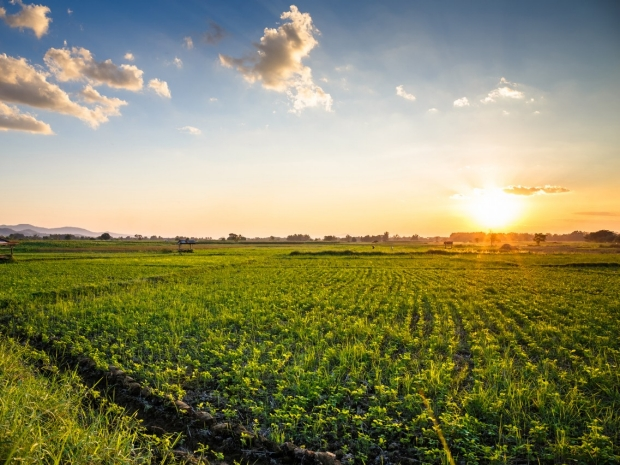Sep 8 2020
Nuts, beans, and lentils are examples of plant protein foods that can offer essential nutrients by using only a small portion of the land needed to produce dairy and meat.
 A peanut farm in Thailand. Image Credit: stevanovicigor/Getty Images.
A peanut farm in Thailand. Image Credit: stevanovicigor/Getty Images.
According to a new study published in the Nature Sustainability journal, a transition to these protein foods could allow most of the remaining land to support ecosystems that absorb the carbon dioxide (CO2) gas.
In this latest study, scientists examined and plotted regions where there is widespread production of foods sourced from animals. Such foods need as much as 83% of the Earth’s agricultural land and inhibit native vegetation, such as forests.
The research work also underscores areas where changing the food grown and consumed by people could free up space for the regrowth of ecosystems, neutralizing the CO2 emissions in the process.
The greatest potential for forest regrowth, and the climate benefits it entails, exists in high- and upper-middle income countries, places where scaling back on land-hungry meat and dairy would have relatively minor impacts on food security.
Matthew Hayek, Study Principal Author and Assistant Professor, Department of Environmental Studies, New York University
When fossil fuels are burned for energy, it releases CO2 that warms the planet. But when this warming exceeds the pre-industrial levels—that is, 1.5 °C or 2.7 °F—more adverse effects such as sea level rise and droughts are anticipated.
Investigators have described the amount of fossil fuel that can be burned before reaching that limit through the global “carbon budget.”
And according to the latest findings, if demand for meat comes down drastically in the forthcoming years along with its enormous requirements for land, then, around 9 to 16 years of fossil fuel CO2 emissions in the world can be eliminated. The removal of such levels of CO2 would effectively increase the Earth’s rapidly dwindling carbon budget by twofold.
We can think of shifting our eating habits toward land-friendly diets as a supplement to shifting energy, rather than a substitute. Restoring native forests could buy some much-needed time for countries to transition their energy grids to renewable, fossil-free infrastructure.
Matthew Hayek, Study Principal Author and Assistant Professor, Department of Environmental Studies, New York University
In the latest report, the authors further highlighted that their discoveries have been designed to help locally customized plans to mitigate climate change. While a majority of the countries are consuming an excessive amount of meat and this trend will continue to increase, raising animals still remains crucial in certain regions.
According to Nathan Mueller, one of the study’s co-authors from Colorado State University, such considerations will be significant as nations try to develop their economies in a sustainable manner.
Land use is all about tradeoffs. While the potential for restoring ecosystems is substantial, extensive animal agriculture is culturally and economically important in many regions around the world. Ultimately, our findings can help target places where restoring ecosystems and halting ongoing deforestation would have the largest carbon benefits.
Nathan Mueller, Study Co-Author, Colorado State University
Mueller is also an assistant professor in the Department of Ecosystem Science and Sustainability and the Department of Soil and Crop Sciences at Colorado State University.
New proposals to cover a large part of the Earth’s surface in forests have created a disagreement as a climate solution. A considerable physical effort would be required to manually plant around a trillion trees. Moreover, poor planning may limit biodiversity, encourage uniform tree plantations, or reduce the dwindling water in dry regions.
There are also challenges in locating sufficient land to keep trees safe from burning or logging in the days to come, discharging the stored carbon back into the air in the form of CO2.
However, when devising the study, the team had kept all these potential issues in mind.
“We only mapped areas where seeds could disperse naturally, growing and multiplying into dense, biodiverse forests and other ecosystems that work to remove CO2 for us. Our results revealed over 7 million square kilometers where forests would be wet enough to regrow and thrive naturally, collectively an area the size of Russia,” added Hayek.
Technological solutions to fix the climate change may soon become a reality, for example, machinery that directly eliminates CO2 from power plant exhaust pipes or the air. But according to Helen Harwatt, the study’s co-author and a fellow of the Harvard Law School, placing too much confidence in such technologies could also prove dangerous.
“Restoring native vegetation on large tracts of low yield agricultural land is currently our safest option for removing CO2,” Harwatt stated. “There’s no need to bet our future solely on technologies that are still unproven at larger scales.”
Nevertheless, the advantages of reducing the consumption of dairy and meat go much beyond the problem of addressing climate change.
“Reduced meat production would also be beneficial for water quality and quantity, wildlife habitat, and biodiversity,” noted William Ripple, the study’s co-author and a professor of ecology from Oregon State University.
The latest events have also underscored the significance of healthy ecosystems in avoiding pandemic diseases with animal origins such as COVID-19.
“We now know that intact, functioning ecosystems and appropriate wildlife habitat ranges help reduce the risk of pandemics. Our research shows that there is potential for giving large areas of land back to wildlife. Restoring native ecosystems not only helps the climate; when coupled with reduced livestock populations, restoration reduces disease transmission from wildlife to pigs, chickens, and cows, and ultimately to humans,” Harwatt concluded.
Journal Reference:
Hayek, M. N., et al. (2020) The carbon opportunity cost of animal-sourced food production on land. Nature Sustainability. doi.org/10.1038/s41893-020-00603-4.